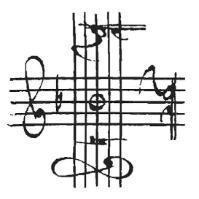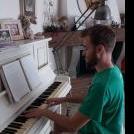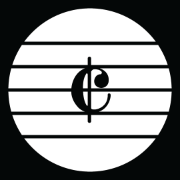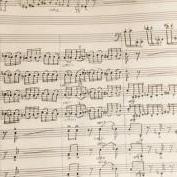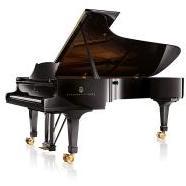Leaderboard
Popular Content
Showing content with the highest reputation since 08/22/2017 in all areas
-
Good evening everyone! I'm ready to present a new piece I have been working on for the last couple of months or so: Adagio for Orchestra. It’s a relatively short piece, not as large in scope as some of my other works I have posted here. Admittedly I’ve had a little bit of writer’s block recently, so I toned things back quite a bit and instead focused on simple themes and experimenting with an expanded orchestra, including Euphonium and Saxophone with the usual instruments. I'm interested in any and all constructive feedback. I had a few goals in mind as I composed this, feel free to chime in on how well I accomplished them: Focus on simple, memorable themes. Experiment with orchestration, using auxiliary instruments to create some unique textures. Integrate Euphonium and Saxophone with the rest of the orchestra. Write something that would work as a middle movement of a larger work, such as a symphony. The piece is loosely structured in a binary form with repeat (ABAB). (0:00 - 1:09) – Introduction. Euphonium solo that is passed between and elaborated by other members of the winds, punctuated by sweeping string lines. Most of the thematic material from the piece is extracted from this opening solo. (1:09 – 2:41) – A Theme. A melancholy dirge carried by a bell-like ostinato played by harp, celesta, and piano, with rustling tremolo in the strings and an eerie chant in the winds. (2:41 – 5:00) – B Theme. A floating theme first presented by the oboe then embellished by the strings to the first big outburst of the piece. Material from the A Theme is elaborated here, then the strings carry the oboe theme to a new momentary high, before settling back into the recap. (5:00 – 7:11) – A Theme recap. The dirge returns, this time building to a euphoric climax, then drifting away into the upper register of the woodwinds and strings. (7:11 – 8:13) – B Theme recap. This time the clarinet sings the theme. I experimented with some polytonality/polymodality/whatever-you-want-to-call-it with the chords in the horns, trumpets, flutes, keyboards, and harp. I’m curious how well I pulled this off. (8:13 – 8:38) – Coda. Return of the Euphonium solo, this time drifting off into silence to end the piece. As usual, I have few specific questions I would like specific feedback on. Feel free to answer as many or as few as you wish: What effect does the music have on you? Does in conjure up an image? Or an emotional feeling? Does it tell you a story? This can be the piece as a whole, or a specific part or parts. What was your favorite part? What was your least favorite part? Do you have any comments or critiques on technique, e.g. harmony, melody writing, counterpoint, orchestration, voice-leading, etc.? How do you feel about the overall form? Is it effective? How well do you think the euphonium and saxophone are integrated with the rest of the orchestra? How do you feel about the harmony in the B theme recap (the nondiatonic chords against the melody in the clarinet)? Is it effective? Do you have any comments of the quality of the performance in the audio file? I really want this to be a decent representation of how the piece would sound if it were performed live, since it is unlikely it ever will be. Feel free to put your "conductor hat" on and critique the "orchestra". I have included a score and welcome any constructive feedback on its presentation. And if you're like me it's a lot more fun to follow along with the score. Are there any composers this reminds you of, that I might enjoy listening to? Sound libraries: Spitfire Symphonic Orchestra and Spitfire Percussion VSL – Eb clarinet, Bass clarinet (in the intro only), Alto sax, Bassoon (for the solo only), Bb Trumpet (for the solos only, and some reinforcement in louder sections), Euphonium, Piano Thanks for listening, I hope you enjoy! If you liked something I did and want me to explain how I did it, feel free to ask as well. -gmm11 points
-
This is intended to be the second part of the second movement of my String Sextet in G flat major, after the part of Lamentoso. These two parts are very different from the more fleeing and transcendental first movement as I hope they capture the sadness of the time and what I feel, before leaping back to the world of the pentatonics later, which would make the pentatonics more grounded. Here is the first movement of the piece: Here is the first part of the second movement of the piece, the Lamentoso, which is actually finished after this fugue: Here are the scores, the original version and a version with my own (painful) analysis on it: Final Fugue from String Sextet movement 2.pdf(With Analysis) Final Fugue from String Sextet movement 2.pdf And here is the youtube video: The piece is dedicated to Mr. Johnson Ho. The finishing of the fugue is prompted by hearing his worsening health, so I really want him to stay healthy. The inspiration of the fugue first comes from my friend Mike @chopin and my mentor David (I am very honoured to name him my mentor even though we have never met in real life since his videos form the skeleton of my composing skill. Go watch his analysis videos NOW!) said that the middle fugato section from the first movement is the best part of the movement. I was shocked since I believed it was the worst of the movement! Then my bro Vince @Thatguy v2.0 (who also makes this perfect audio) inspired me to write a dense fugue for the second movement, and so I challenged myself to write a six part fugue, since I feel like it’s not fully realised in the first movement. This is he most difficult I have ever written, but finishing it I now consider it my most beautiful work composed up to date. It’s so emotionally deep, even weirdly I feel zero emotion during the composition process, only calculating the counterpoint haha. I am so satisfied with the result. The fugue comprises of three subjects, all from the 1st movement. The 1st and 2nd subjects are from the 1st movement fugue’s subject, while the 3rd subject is derived from the opening theme of the Sextet’s first movement. Here is the plan of the movement (time according to youtube video): First part (00:03): First subject enters in each instruments, inversion introduced at . All of sudden C minor enters (01:55) and I quote my subject of the C minor Clarinet Quintet 3rd movement fugue here to intensify the sadness. Also kind of replying to the relationship of G flat major and C major in the first movement, but while freedom is shared there, now sadness is shared. Second Part (02:12): Second subject enters and the section features a saturation of stretti. The C minor section (03:56) comes in at and it’s my favourite section of the whole fugue. It’s insanely tragically beautiful here. Third Part: Third subject enters (04:58), first and second subjects combine in the manner of the 1st movement fugato. The intensity is kind of lowered after that insanely tragic C minor section, maybe kind of accepting and reflecting upon it, and it’s less saturated with the subjects. However things starting to get intensified, first the third subject is treated as in Bach’s Chorale Preludes when it is cut up and divided to four phrases alongside the other two subjects (06:29). The only pentatonic entry (07:16) arrives to kind of relate itself to the first movement and hints what will come at the end, but at the meantime it’s defeated by disappointment and the fugue ends in a doubtful manner, which will lead to the chant section. Hopefully I would finish the whole movement as soon as possible! Hope you enjoy the fugue now! Henry10 points
-
So this is the final draft of the entire 2nd movement of my String Sextet. I can confidently say this is my best movement of music ever written up to date. The movement is divided into three parts: Lamentoso, Fugue a6 and the Return. The first two parts of the movements have been posted before in below links: Lamentoso: Fugue a6: If you want to skip to the newest content I compose, you may skip to 20:16. The musical analysis of the Lamentoso and Fugue have already been done in the link posted above so I won’t repeat it here. Here is the YT link and score of the movement: (Final Draft) String Sextet 2nd mov with last page.pdf Here is the YC post to the first mov of the same Sextet: Here is the structure of the movement: 00:00 Lamentoso The Eden in the 1st mov is great but man, come on and live in the real world. All sorts of tragedies happening and what ground do you have to claim the transcendence? I especially love the outburst in 4:59 and the passage starts from 8:53. 11:47 Fugue a6. This part is totally inspired by Vince’s @Thatguy v2.0 comment on my first movement “to write a dense fugue”, also to further explore the fugato in the 1st mov. Like @Giacomo925 said, this part summarises the sadness of the first 20 minutes of the movement. It always leaves me in awe that my favorite C minor passage, the absolute climax of the whole piece, lies in minute 30 exactly. The fugue aims to end on desperate terms but I won’t allow it. I try to give it a fight by recalling the pentatonic ideal even though in the wrong key of the tritone C major as hinted in the pentatonic section of the fugue, but the power is diminished. I need some purification for the paradise regained. Thx to @Luis Hernándezfor introducing me to tritone substitution in this part. The chant (22:01) begins with self murmuring of viola, occasionally inviting mysticism recalling 7:55 in Lamentoso and sadness of the 1st subject of the fugue. Two violas play together with the texture of a parallel organum. After a sad cry some more primitive power comes in to recall the passion and good of human beings, the theme is from b.27 of 1st mov. It gets agitated and experiences an epiphany in the form of Bartok Pizz. Both the chant and the folk melody is built around the 025 set! And the 025 set is the essence of the pentatonic scale! Furthermore a quartal chord is the further essence of 025 set, and hence the core of the whole pentatonic scale! Discovering this, the fury cannot be stopped. It leaves me in wonder how on earth can I write this thing out. After returning to the tonic key in 27:00, I decided to conceive it as a one off climax with build up. The idea is inspired by my playing of Beethoven’s op.110 when he did the same thing in the last movement as well. There is no “development” but only realisation of Tao in this imperfect world. There are appetizers to the ultra climax, first introducing the two most important themes sparingly, then in 27:16 theme in b.35 of 1st mov which is in fact inspired by my own Clarinet Quintet in C minor, and then an appetizer fugato responding to the lament in b.148 of the Lamentoso which is based on the opening theme. The entrée of Ultra Climax appears in 28:38, first is the first theme in tonic by first violin, viola, and cello, then second theme in C major by second violin, viola and cello. The playing of tritone is to prove Tao‘s omnipotence, also respond to the first mov and the fugue with the F# and C minor relationship. Using all 3 instruments for me is the resonance of Heaven, Earth and Human when they finally sing together the Tao they shared. I think I really feel the Chinese philosopher Tang Chun-i’s Realm of Heavenly Morality here. The modulation to Ab major, responding to b. 294 and 644 of 1st mov, complete what’s left undone there and finally Gb major is in triumph. A pedal point on a tritone is funny for me. The cello overlapping the violin is signifying earth and heaven interaction which is considered auspicious in Chinese classics I-ching. I am always in awe of the power exhibited here and wonder who’s actually the composer of this passage. The next passage in 30:07 is the heterophonic version of the 1st theme, which is where I was inspired miraculously by a Chinese music group. Next is the in extremis passage in 30:57. It’s the immanent version of the 1st theme. I was imagining what my friend’s thinking on his last day of life. The texture is probably inspired by the film music in Kurosawa’s Ikiru when the main character was swinging on the park’s swing to await his death. I quote Bach’s St. John Passion here for my friend’s name, and I find out that the lyrics fit too. I wish him to rest in peace and return to Tao. The final ending is probably inspired by the ending of Chopin’s Fantasie in F minor. I can never believe I would end the whole thing this positive in an absolute way. The whole passage always leaves me in tears. After writing the Lamentoso in May 2024 I had no power and inspiration at all to write anything in the Sextet since I was suffering in my full time job. I started picking up by working on the C# minor Piano Sonata first. After finishing that in Jan 2025 I felt like my negative power was expressed out, leaving the goods for this Sextet. I then went for a walk on 10 Feb 2025 and had a miracle, inspired by a Chinese music group, which turned on my creative power and I fervently completed the entire thing in just 18 days, when I had zero notes written in the past 9 months. It’s such a miracle I could have finished this piece this quick and good. My dedicatee Mr. Johnson Ho had already passed away last year. It's a shame that this piece couldn’t be completed when he’s alive, but I would be forever thankful for his inspiration. Special thanks must have been granted to my great friend Mr. Vince Meyer @Thatguy v2.0 for making this perfect audio and many ideas, and being a great friend, but I will leave it to the final version of the whole Sextet. Also a very special thanks must be given to my ex-boss. Thanks to her mistreatment, I have the pain to reflect on my own, the drive to finish the whole Sextet in a fury and the time to complete it when I was forced to resign for my own mental health. Foremost of course I must thank my dearest mum. But lol, the whole acknowledgement will be left to the post of the final version of the whole Sextet, including the first movement and this movement. This is a very long movement and commentary and I don’t expect anyone to listen and read till the end. But if you do so, here is my deepest gratitude to you. Feel free to comment as well, I would be very thankful to have received them. Thank you!!!!! Henry10 points
-
Hi all! This is the second movement of my Piano Sonata in C-sharp minor. It is set in the relative major E major to act as an (apparent) counterpart of the furious first movement. Pentatonics and Locrian scale are added in the movement, but the motive of fourth from the first movement is important here as well. Here is the Youtube video link: Here is the pdf and audio of the score: Final Draft Piano Sonata no.3 in C sharp Minor 2nd Mov.pdf Piano Sonata no.3 2nd Mov.mp3 The movement is set in a rondo form ABACA. Here is the structre of the movement: 0:00 Introduction & 1st Refrain: The Locrian scale is used capriciously at the beginning by a confused Henry right at thr start of composing the movement when he didn't know why he used it but still retained it to see what would happen. The main theme (00:23) begins in a quite beautiful pentatonic E major. I love the German Sixth used in 00:53 and I absolutely love the C-sharp minor contrasting theme, as it's beautiful but at the same time coherent by using the falling fourth motive from the beginning of the 1st movement! (Btw it is quoted in parody in my joking fugue) It then unoriginally modulates to dominant B major. 01:32 repeats the whole process apart from some embellishments. 2:34 1st Episode: The beautiful (I think) 1st episode is actually composed the second last one, only before the last refrain. It's Chopinistic here, but I think it's quite beautiful! The theme is roughly the inversion of the 1st theme. I had the inspiration of this beautiful theme when waiting in a queue in my ex-company's canteen LoL! I love the counterpoint in 03:43 as well, again using the falling fourth motive. The C-sharp minor is never solved and merely forced back to E major with a quite beautiful G sharp major transition to the 2nd Refrain. 4:29 2nd Refrain: The first theme is turned to a bell texture which I must have taken inspiration from Brahms's op.117 and Prokofiev's Sonata no.6. The serenity proves short-lived as the mood starts to become agitated and the falling fourth motive starts to attack. 5:12 2nd Episode: The Locrian scale starts to disturb and the keys start to moving all around, again in 05:30 the agitation proves itself it is not going to be covered at all, and with octatonic modulation it ends on G minor which sounds like the beginning of Chopin's 1st Ballade in 05:41. The first theme enters in 05:53 but is only a false recap as the stirring continues once again in a semitone higher in a Schubertian fashion. The first theme re-enters in 07:07, this time in C-sharp major, the global tonic major but with undercurrent underneath. F minor disturbs once again as in earlier as well as the development of the 1st movement, and the Locrian mode is finally forcefully purified to a pentatonic. I think the retransition here is slightly abrupt and forceful. 8:16 Last Refrain: First theme appears with the purified locrian scale turn to pentatonic crystal in the upper register of the piano. The contrasting theme is set in F-sharp minor this time for the E major confirmation. The C-sharp minor is not answered at all again in 09:17, and only forcefully shut up, and the piece ends in E pentatonic. At least a momentary serenity can be achieved before facing the disasterous 3rd movement. This movement starts in 2023 June right after the completion of the 1st movement, but was abandoned since I had to focus on composing the 2nd movement of my Sring Sextet. Then after a personal crisis in 2024 I had no energy at all to compose, and I hoped to use this movement to pick up my creative energy. It succeeded and the movement is quite beautiful in my opinion. I expanded the movement from a ternary one to a rondo with the addition of the 1st episode and completion of the last refrain. The movement may sound too Chopinistic and less original, but I definitely pour my heart here. I just maintain the “write-what-I-want approach” in the whole Sonata without much thinking, planning, or trying to be original. I just don’t want my emotion disturbed by the chasing of originality when expressing my feeling is my ultimate concern in the whole Sonata. The recording is played by myself. I buy a new microphone I hope the recording quality will be better and not to be roasted by @chopin anymore! Feel free to comment or critize this piece below! I will be more than happy to hear any opinion whether it's positive or negative! Hope you enjoy it! P.S. Here is the link for the YC post of the 1st movement from the same Sonata: And here is the 3rd and ending movement of the Sonata! Henry9 points
-
Good evening everyone! I'm excited to present a new piece I have been working on for the last month or so: Scherzo for Orchestra. I deliberately wrote this fairly quickly, with the intent to write something fun, conventional, and maybe even a little whimsical. I'm interested in any and all constructive feedback. I had a few goals in mind as I composed this, feel free to critique my success or failure on these: Write something a little more informal and accessible, with catchy, memorable themes. Start with a very simple idea, and build the entire piece off of it. The four bar opening phrase in the 2nd violins popped into my head one day, so I tried to build the entire piece off of this motive and transformations of this motive. Practice having multiple contrapuntal lines. Some details on this are below. Write something that would work as a middle movement of a larger work, such as a symphony. Write something under 10 minutes, since I might decide to enter it into a competition and a lot of competitions have a 10 minute time limit. The piece is loosely structured in a three-part rondo form (ABACABA). (0:00 - 1:32) - A Theme - A very quick staccato theme in C# minor. I based this on the idea of a fugue, with each voice entering at different scale degrees, before they all come together to cadence. I'm sure I broke a few rules on the counterpoint, but it got the job done. The section ends on the V (G# minor) (1:32 - 2:21) - B Theme - A soaring theme in E major, then restated in Db major. Here I tried to have descending chromatic lines to complement the ascending melody. (2:21 - 3:04) - A Theme - Restatement of the second half of the A Theme, this time ending on I (C# minor) (3:04 - 6:31) - C Theme - A waltz in D major that begins very timid, gradually gains confidence, and goes out with a bang. (6:31 - 8:01) - A Theme - Restatement of the A Theme, this time in D minor, with the orchestration modified slightly. I threw in a couple unprepared modulations up a half step, to Eb minor and E minor. As a result I may have broken a "rule" here since I ended the section on B minor (which is not the V of D minor, the key I eventually return to). (8:01 - 8:49) - B Theme - Restatement of the B Theme, this time in Db major and Bb major. (8:49 - 9:37) - A Theme - The second half of the A Theme again, eventually returning to D minor to end the piece. As usual, I have an onslaught of questions I would like specific feedback on. Feel free to answer as many or as few as you wish: What effect does the music have on you? Does in conjure up an image? Or an emotional feeling? Does it tell you a story? This can be the piece as a whole, or a specific part or parts. What was your favorite part? What was your least favorite part? Do you have any comments or critiques on technique, e.g. harmony, melody writing, counterpoint, orchestration, voice-leading, etc.? How do you feel about the overall form? Is it effective? Do any of the parts seem impractical to you? It's a pretty fast piece with a lot of technique, so I'm curious if some of the parts are impractical. I don't mind them being difficult, I would only be concerned if they are borderline impossible. Do you have any comments of the quality of the performance in the audio file? I really want this to be a decent representation of how the piece would sound if it were performed live, since it is unlikely it ever will be. Feel free to put your "conductor hat" on and critique the "orchestra". I have included a score and welcome any constructive feedback on its presentation. And if you're like me it's a lot more fun to follow along with the score. Are there any composers this reminds you of, that I might enjoy listening to? Sound libraries: Spitfire Symphonic Orchestra and Spitfire Percussion VSL Trumpet (only for some of the lyrical trumpet melodies) VSL Violins (only to layer with the violins in Spitfire) Thanks for listening, I hope you enjoy! If you liked something I did and want me to explain how I did it, feel free to ask as well. -gmm9 points
-
Good evening everyone, I am excited to present a new piece I have been working on: "Sinfonietta No. 2 for Large Orchestra". I have been working on this piece since last December (with a few interruptions due to the pandemic and life in general) and just added the finishing touches this last week. I chose what you might call an "extended" sonata form, with a longer introduction, exposition of two themes, development, recapitulation, and resolution/coda. I am interested in any and all constructive feedback. Since I just completed this piece, I'm very interested and open to ideas on how it could be improved. Like my last work, it is a little long clocking in around 20 minutes, so I broke it up into "chunks" if you want to listen a little bit at a time: (0:00 - 4:12) Introduction (0:00 - 1:33) A piercing opening that leads into a stormy "Infernal" theme (1:33 - 3:48) An ominous theme that leads into a passionate proclamation (3:48 - 4:12) - Brief return of the opening theme (4:12 - 5:48) Exposition of Theme A, a thundering overflow of aggression (5:48 - 6:32) Brief Transition from Theme A to Theme B (6:32 - 8:19) Exposition of Theme B, a wandering chromatic theme underscored by a heavy ostinato (8:19 - 14:03) Development, referencing and expanding the themes above, while deriving a few new ideas from the themes as well (14:03 - 15:35) - Recap of Theme A, transposed (15:35 - 16:00) - Brief Transition form Theme A to Theme B (16:00 - 17:45) - Recap of Theme B, transposed (17:45 - 20:18) - Resolution/Coda, a somewhat impatient, but ultimately triumphant finale As you listen, there are a few things I would like to hear your opinions on: What effect does the music have on you? Does in conjure up an image? Or an emotional feeling? Does it tell you a story? This can be the piece as a whole, or a specific part or parts. What was your favorite part? What was your least favorite part? Do you have any comments or critiques on technique, e.g. harmony, melody writing, counterpoint, orchestration, voice-leading, etc.? How do you feel about the overall form? Is it effective? Do any of the parts seem impractical to you? I tried to challenge myself with this piece and as a result I wonder if I pushed the expectations of some of the instruments too far. For example, I included "optional" Eb and D clarinet parts for some of the higher clarinet parts, but I'm not sure if it was necessary. I'm also not sure if some of the string technique in Theme A and the "Infernal" section is practical or not. Do any clarinet players or string players have any insight? Do you have any comments of the quality of the performance in the audio file? I really want this to be a decent representation of how the piece would sound if it were performed live, since it is unlikely it ever will be. For example "I would have liked xxx instrument to be louder/softer here" or "The xxx instrument technique sounds sloppy here and could use some cleaning up" or "The balance in the xxx section was all out of proportion" I have included a score and welcome any constructive feedback on its presentation. And if you're like me it's a lot more fun to follow along with the score. Do you think "Sinfonietta" is a appropriate designation, or would you call it something else? If you could name this piece, what would you name it? Thanks for listening and I hope you enjoy! As always, if you liked something I did and want me to explain how I did it I am happy to do so. Or if you just want to tell me it's awful that's fine too. gmm9 points
-
Hello there. This is a solo guitar piece I recorded for a video that's being made. The details of it aren't final, but there will be dancing in the woods, and things to that effect. I have this tabbed out, so if there's any interest in seeing that I'll make it look pretty, but otherwise, I hope you enjoy! Oh yeah, it's about a girl 😄8 points
-
Hi everyone! I'm here to present my most recently finished work, the first movement of my String Sextet in G-flat major. I name this piece a subtitle of Heaven, Earth and Human to express my view on their relationship. (What a self bragging guy this is...) The piece is dedicated to my friend Johnson Ho. Guys and gals, please help me pray for his declining health and wish him all the best. He is definitely one of the reason why I start this piece and the reason why I finish this piece. Special thanks to @Thatguy v2.0 with his always original ideas which sparked my inspirations and new thoughts. Every time after discussion he always gives me new ideas on my composition and musical idea. And he's the one who make this audio perfect in my opinion. Thx so much and I'm so happy I get to know you in this forum and become friends with you as my musical guidance. I will post the mp3, pdf and YT video here first since I'm going to brag all those details after it haha🤣: Final First Draft of First Movement of String Sextet.pdf Final final first draft 01-06-2023 First Movement of String Sextet in G flat major.mp3 https://youtu.be/cI8MAn2XEPk If you don't want to read them, just ignore them!! (spoiler alert)😀😃😄😁😆😂🤣🥰😍🤩😘🤑😵🤢🤮🥶😨😱😭(spoiler alert) (spoiler alert) 😀😃😄😁😆😂🤣🥰😍🤩😘🤑😵🤢🤮🥶😨😱😭 (spoiler alert) (spoiler alert) 😀😃😄😁😆😂🤣🥰😍🤩😘🤑😵🤢🤮🥶😨😱😭 (spoiler alert) (spoiler alert) 😀😃😄😁😆😂🤣🥰😍🤩😘🤑😵🤢🤮🥶😨😱😭 (spoiler alert) (spoiler alert) 😀😃😄😁😆😂🤣🥰😍🤩😘🤑😵🤢🤮🥶😨😱😭 (spoiler alert) This piece is inspired by the thoughts of the great New-Confucian Chinese philosopher, Tang Chun-i. I immerse much in his philosophy and am always delighted reading his huge books. This work is particularly inspired by his thoughts of 9 states of mind, and I really hope I can depict what I feel towards the ninth state, the state of Heavenly(天) Morality Transcending (sorry for my bad English Translation... but this is way too technical for my standard....), his philosophy and Chinese thoughts in general. I choose G-flat major as the tonic since 1)the initial inspiration comes in this key, 2)it's the key of transcendence for me, 3) I want the sound less bright by get rid of those open strings notes, since truth for me is Aletheia in Heideggerian sense, which is hidden but to be disclosed only, rather than a bright thing to have. I know there are some discussions concerning key choice of strings recently, so I'm clarifying here. I had my initial thoughts for this piece in 2021 May when I woke up midnight, but then I was busying with my composing of Clarinet Quintet in C minor and thus ignored it. I wished to continue it in 2022 August after finishing my Quintet, but find it real hard to continue since I don't have the craft to do it. Until I joined YC and saw the following two posts: (Hey Jean @Jean Szulc I said I would learn something from your piece, and this is the product!!!!🤘🤘🔥🔥 Thank you! Will you post here again?) (Yo Vince my bro!!!🤘🤘 Thank you!) These two are absolutely great pieces (go check for them! Vince's piece is still on the "Our Picks" section) and they use the quartal harmony so well. I also learn from Jean's piece on the more extended techniques for strings. Then I had some ideas to finish the piece. This one gonna be something Chinese which is weird in a sense that despite being a Chinese I never write something Chinese. It's always Beethovanian and I really would like to reduce that element in my new piece. After writing the Clarinet Quintet in C minor, especially after having complete an all-controlling piece (esp. the 4th movement), I realized that I have too much reliance on forms and motives and I hope I can make them less explicit in my new piece. I love sonata form very much, but you cannot compose every pieces in it. And for me all the hard work pays off. For the instrumentation is two violins, two violas and two cellos. I love how the addition of 1 extra viola and cello (to a standard String Quartet) thickens the voice and strengthen the middle and low registers. It also gives more chance for viola and cello to sing while having their partners doing the accompaniment. For me the violins stand for the Heaven, violas stand for human and cellos stand for earth, though this is not mandatory interpretation of the piece as it's not always strict imagery. The structure of this piece is more a 3 part one. I have added some rehearsal marks on it to indicate the parts, and I will describe below with some (hopefully) interesting thoughts: (Timepin according to the video) First Section: 00:06 A, main theme. The accompanying texture comes from the first movement of Brahms's String Quintet no.2, one of my favourite of his piece. It starts with viola to emphasize the human call for me. Notice the theme in viola II in 00:23. That theme will appear throughout the whole movement. (Is this a Qi(氣) theme?)00:31 another important theme. 00:38. I like this theme for its contemplative nature. The theme comes from my Clarinet Quintet in C minor. Can you find it? I find it two days before in a wonder LoL. 00:54 B, continuation in high register with added voice. 01:24 C, transition, old theme disguised as a new one. 01:54 D, in D flat major/Mixolydian. The "Heaven" section in my original planning. 02:36 E, continuation in G flat major. 02:59 F, I love the conclusion in 03:13 very much. Modulate to C major to next section in 03:42 and I love the transition so much since it's real hard to compose. 03:42 G, the "Earth" section in my original planning, with cellos taking the lead 04:12 H, repeating the earth section in G-flat major 04:35 I, closing of first part, one of my favourite portion of the movement. I especially love that A-flat major outburst in 04:46. It's magical and I have no idea where does it come from as I only realize it's composed after I finish it. I always imagine Leonard Bernstein conducting this part, LoL. Very synchorinzed here, but it's denied and turn to minor (which will be further developed in the 2nd movement) Second Section: 05:21 J, the minor section. I believe this is the worst part of the movement but Vince's audio saves it. It appears a bit anguished here. The new theme in 05:28 is the basis of both section II and III. Some sort of fugato and imitations happen here though it's not time for it. 06:47 K. I love this part!! Very fluent in violins, and I like 07:06. It's a diminution of the theme of the previous part. I use sul ponticello here to make the sound more silvery. 07:29 L. Trying to reach back to opening section by quoting the first three notes of the theme. But it's external only since it's in F sharp major. Maybe the key difference is only visual and I may change it to G flat major. Also I don't know whether the harmonics work for the violins. I like this section though. 08:24 M. A pizzicato section further developing what's doing in part L. Daniel @Omicronrg9 must have inspire me for this part. I like the contemplativo section in 08:56 too with some call and response between the two violas (humans) 09:34 N. Transition to section III. I freakingly love this part! The transition for me is smooth, and it's transforming the minor theme of section II to a major/pentatonic one. Third Section. 10:05 O. Introduction of the fugue subject. 10:20 is the start of a triple fugue, with the subject in Violin the main one for me. 10:52 theme from 00:38 quoted. Subject through G flat, Eb minor, G flat. 11:10 P. First longer episodes, theme from part F quoted Subject through D flat. I love the preparation for the first climax of the fugue in 11:41. I love the climax in 11:48! Subject in G flat. 12:03 Q. Another episode to direct to C flat major. Themes in part D and the theme in 00:31 quoted. Subject in C flat and A flat minor 12:42 R. The great Con spirito! One of my favourite portion of the movement, The A-flat major is chosen to echo in climax of section I in part I. Final appearance of the subject of the fugue in climactic G-flat major, and leads directly to the coda. In 13:17 I have a moment when the first cello is higher than the violins to correspond with a Chinese philosophical concept in the book of Change, when the power of earth is up and the power of heaven is underneath, it's auspicious since the heaven and earth are communicating instead of isolating themselves. The Chinese words 乾下坤上 is written in the score though lest you know Chinese haha! 13:28 S. Coda, with a decreasing of tempo. I am initially perplexed whether to write like this, since my little Wind Quintet piece has kind of same treatment in its coda. But I just decided to write like this since it's beautiful and the two pieces are interconnected anyway. I want this passage to be like human successfully synchronize with the heaven and earth. It's quite similar to a Chinese opera here in my opinion. I freakingly love that half cadence in 14:03!! The coda ultima in 14:08 is written much earlier, in Nov 5th 2022. I know the conclusion but find the ways to it very difficult. But I'm happy I am able to achieve this ending!! This plan to be a 2-movement work, but I'm not gonna compose the 2nd movement until I'm ready. It will be very different from this movement though. It's such a long post LoL. Feel free to criticize or critique it if you have anything you don't like about it, or compliment it if you want! I don't mind any comments and I will love to have all of them whether they are long or short, good or bad, positive or negative! Thanks for listening! If you happen to read through this LONG post, thanks so much for it!!!!! I have too many things to tell LoL. Love y'all!! Update: The first part of the second movement of this Sextet is posted on Jun 2024: The second part of the second movement of this Sextet is posted on Jan 2024: And here is the entire second movement posted in March 2025: Henry8 points
-
The competition is now closed to further entries! Starting Sunday June 18th, 2023 and running until Sunday, August 13th , 2023 Young Composers Forum invites you to participate in yet another new and unique music composition competition hosted by @Thatguy v2.0, @PeterthePapercomPoser, @Henry Ng Tsz Kiu, @Omicronrg9, and @chopin, all of whom will also judge the competition. Dreams pervade our lives in a myriad of ways. Symbolic dreams, prophetic dreams, anxiety dreams, and lucid dreams are just some among our repertoire of night-time excursions. In this competition, the oneironauts (dream explorers) are tasked with writing a piece (or song) for one monophonic instrument (or voice) and one polyphonic instrument, based around the idea of dreaming, a specific type of dream, a particular dream that the oneironaut wants to share in their music, or depicting a famous dream story or poem such as Edgar Allan Poe's "A Dream Within a Dream". The way in which each oneironaut chooses to do this is totally up to their particular taste and interpretation, the only strict guideline being the instrumentation. The monophonic instruments (or voice) which are allowed include even string instruments which can play multiple notes at once, but do not customarily do so all the time (such as the Violin, Viola, Cello or Contrabass). And possible polyphonic instruments include but are not limited to: Piano, Harp, Guitar, Accordion, Organ, Harpsichord, and etc. Edit: Midi keyboard synthesizers are allowed as long as the part can be performed by a human being. Delay effects are also allowed, although looping pedals are not as they would defeat the purpose of writing for one instrument. The submissions will be judged on a scale of 0 - 10 in the following 8 categories: The scoring categories are pretty self-explanatory. The Taste category is for the judges to score how much they personally enjoyed any given composition, while the other categories are expected to be scored more objectively. The oneironauts names will not be revealed to the judges until the judging is complete. The prizes will consist of $100 1st prize, $50 2nd prize and $25 3rd prize regardless of the number of participants. Also, if there will be any popular voting polls they will not include 1st, 2nd and 3rd place picks as the judges have determined that this portion of the competition may have been a bit redundant in the past. In order to compete: Your composition must not exceed 15 minutes of music and must be at least 3 minutes long If you are a new member, please submit an unrelated original piece of music to the forum to qualify (create a new topic) Your composition must be somehow based on dreams Instrumentation must be for only 1 monophonic instrument (or voice) and only 1 polyphonic instrument No age limit One submission per participant Mp3 submission and score/sheet music pdf required including a description $100 1st prize, $50 2nd prize, $25 3rd prize Deadline: Sunday, August 13th, 2023 Submissions are to be sent to @PeterthePapercomPoser through direct message with the title of the composition as the subject line. He will post the submissions anonymously in a special contest thread for everyone to listen to and consider. Besides attaching a pdf score (without your name in it) and mp3 rendition of your music you must also include a description of your piece for the judges, fellow competitors and young composers at large to better understand your music. How did you incorporate the idea of dreaming into your music? Feel free to include the description of the dream, dream story or dream poem that you used. To view the submissions thread go here: To view the results and winners thread go here: To take the "Dreamscapes" Satisfaction Survey go here: To vote in the popular voting polls go here: Current Entrants: (reply to this thread in order to enter) @expert21 @Bacon Danger @ComposaBoi @Left Unexplained @IanBoins @veps @Samuel1 @AlexeySavelyev @PCC @GreenGiantCanOfCorn @Michalis @44W74l4 @SorooshMHS @jojojo @popsinn @Beethoven is God @Jordan Jinosko @Camfrtt @AngelCityOutlaw @MusicianXX12 @bkho @ComposedBySam @Samuel_vangogh @NicholasG @Minerscale @José de Azevedo Souza @Composer from Europe @spike473 @Paweł Siek @Sergio Moreno @Irene Huang @MTK8 points
-
It's that time again. I may have gotten weird with the score.8 points
-
The Ballade in E-flat minor was written in 2021. Though it is written for solo piano, I had intended to write it for piano and orchestra, and may make a version of it for this ensemble in the future. The piece is about 8 minutes long. I hope you all enjoy it 🙂8 points
-
The final piece of my four Piano pieces set and just a lame joke. Can be developed into a postmodern minimalistic masterpiece by repeating the joke forever and forever...... Joke in A flat major.pdf Hope you enjoy this one! Henry7 points
-
ello everybody, I've spent many months working on three short new piano pieces for beginning to intermediate students. These are originally intended for children to play, but could also be for beginning adults. In these pieces, I've also tried to discover my own voice and style, do let me know how I've done in those areas. Other feedback related to technique, harmony and playability would be much appreciated. Poem 1: "based on a theme by Beethoven", updated score Poem 2: "the quirky detective", updated score Poem 3: "the crazed capybara", score7 points
-
The Image in G major is the third piece of the four piano pieces I wrote for relaxation after writing the very heavy String Sextet. I try to do something a bit different than the previous two pieces, as I actively use more quartal chords and pentatonics in the whole piece, and also invite a bit of impressionistic chords. This is my personal favourite of the set. Here is the score and YT video: (Final) Image in G major.pdf Like the previous pieces, this one also comes from recycled materials. It comes from an unfinished Piano Suite I composed in 2016 Jan, but only with fragments of it including the first few bars, b.35-38 LH melody and some parts of b.58-72. Don’t know why I went for pentatonics that long ago LoL! One thing to note: b.43-46 is probably inspired by @Fugax Contrapunctus Pabio’s mention of Joe Hisaishi in his review of my Sextet, plus my recent listening experience of his music while watching Miyazaki’s films. Hope you enjoy this small piece! Henry7 points
-
This might actually be my best current composition. It is my weirdest piano piece for sure. I built the harmonies and "melodies" from a chromatic superset (3+4+5). I can explain it better if I see interest. It took me around 5 hours to compose this piece and I have to say that it is a true nightmare to learn it and play it without many mistakes. I pray for the people who decide to start learning it hahaha. Some of the jumps are actually scary. The piece has an improvisatory nature like some of my other compositions, but this time it is easier to imagine a horror plot behind it. Also I think there is no official performance version of the work, you can play it very different to the way I played it today. Here you have a performance a friend of mine recorded: I hope you enjoyed it! Let me know if you have any doubt or advice.7 points
-
I've been listening to a lot of your music this week and last to help me with my videos. Here are some of the compositions I've listened to. These pieces were either used in my latest videos or I was highly considering making use of them (all opt in): REGENERATION by @Jordan Jinosko A beautiful symphonic work that made its debut in my explainer video Caprice in Seven by @Mikebat321 Very fun piece, made it in my explainer video Aria Of Shadows by @Nikolaos Dimopoulos Great adventurous piece here, the mood just didn't quite fit what I was looking for in my latest video. But a strong contender for future videos for sure. Desert Temple and Sky Temple by @Zeldz Give these a listen! They are superb. Sky Temple made its debut in my latest video actually. And Desert Temple has so many applications for future use in a video. String Sextet in G Flat Major by @Henry Ng Tsz Kiu Gotta love Henry's Sextet! A complex piece, but there are so many goodies here, was used in an explainer video Acciaccatura Study for Violin and Piano by @Carl Koh Wei Hao This one made its debut in my latest video about Chopin, since I talk about acciaccaturas! Mathieu's Submission (For a Ryal Leach Competition) @Mathieu This one is really good if I ever need some type of "suspense" theme!....I am a fan of the Horror genre, and I have added some horror elements in my latest videos. Caprice for solo violin no 3 and 1 and 2 (linked in 3) by @luderart The style can work very well when you only want one voice to convey a certain mood. I've also listened to parts of Chopin's Fantasie Impromptu and Piano Concerto 2.7 points
-
This is not a dance suite, but is made out of old pieces in my dance suite folder that didn't make the cut (back when I was writing into the sequencer). The 1st movement - Serenade - is a fast ternary form in Ab major. Originally it was meant to be a prelude to a dance suite. It is in 4/4. The 2nd movement - Lament - was originally meant to be a Courante, but it doesn't satisfy the requirements of the kind of dance that a Courante is meant to be (and it's in 2/4). This piece is in Ab minor and binary form. The 3rd movement - Intermezzo - was also conceived as a prelude to a dance suite. It is in F# major. It is in 4/4 and binary form. The 4th movement - Postlude - was originally meant to be an Allemande but ended up being too slow to be any kind of dance, even though it has some characteristics of an Allemande. It is in 4/4 and E major. The overall form is fast, slower, slower, and even slower. Let me know what you think! I appreciate any of your constructive comments, suggestions or critiques!7 points
-
Hi everyone, For those who don't know me my name is Camille, I'm French and I'm 17 years old. I'm familiar with classical music and orchestral litterature and I often compose for piano and orchestra. These last 3 months I composed a piano concerto in C minor. This is my big project of the moment and also the one that took me most time to compose. I create this topic to share the first movement of this piano concerto. It lasts about 17 minutes and follow a strict sonata form. I took the habit to compose a piano concerto per year and this is what I consider my most accomplished piece so far. Here is below the score and the audio. Enjoy the music, and, please, tell me your opinion about this composition. STRUCTURE OF THE MOVEMENT : INTRODUCTION : M. 1-31 (Moderato, TEMPO I) : Orchestral introduction, statement of the first “theme” on cellos and violas. Dramatic crescendo until the piano entrance M 31-39 : brief piano cadenza allowing the listener to be more familiar with the main theme/material of the piece. Little arpeggios … EXPOSITION: M. 40 – 76 (Allegro) : This is the one ! After a short motif used later in the concerto (in the cello/bass part) statement of the THEME 1 A (violins parts) that as been stated in the introduction. Repeated in piano part m.57. The reappearance of theme 1A leads to a dramatic climax m.70 (being the continuity of 1A). M. 77 – 120 (Vivace) : THEME 1 B. Much faster, this theme consists of a repeated eight-notes pattern in the woods. The piano responds with an avalanche of sixteenth notes. Until m.120, strings are an accompaniment. Main motives are stated in the woods (such as the motif m99, flutes and oboes, it will appear later in the development). The pianist is showing is virtuosity in his modulating part and is assisting the orchestra. M17-20 : end the of first theme with a frenetic climb. M 120-127 : Transition to THEME 2. The piano part is quoting 1A and the clarinets are stating a thematic material of transition later used in the development. The rhythm seems to slow down allowing a quasi-cadenza in piano part (m127) leading to… M 128-150 (Andante) : THEME 2A. Lyrical theme (piano part) that appears 3 times, each one being richer in accompaniment and chord. The 3rd one is introduced by the clarinet material OF m120-127. M 150-169 : THEME 2B : consisting (mainly) of one quarter note and six descending quavers. Again, a virtuosic piano and a support orchestra merges and form a whole for this 2B. M 170-184 : Return of THEME 2A but in a heroic climax where the piano supports the orchestra with arpeggiated chords. Transition with big orchestra chord until… M. 185-194 : ENDING OF EXPOSITION : Theme 2A and 2B are combined but in a the minor key of C to allow the arrival of … DEVELOPMENT: M. 195 – 215 : A repetition of the orchestral introduction with a few small things arranged to lead to the development M. 215 – 250 : Basically THEME 1A is all over the place, dissected, disguised, modulated. Have fun trying to count how many times it appears, you will be wide of the mark lol (You’ll notice, by the way, the transition theme M247, clarinets). M. 251 : 266 : Same thing as m215-250 but with THEME 1 B. M. 267-280 : mish-mash of T1A and T1B leading to CADENZA: M 280-323 : The cadenza is divided in two parts each one being a recapture of T1A. One is aggressive and fast while the other must be played maestoso. M 323-337 (En ralentissant tempo T2) : THEME 2 A being stated in the form of a bucolic love letter leading to M. 339 – 350 (Tempo I) : orchestral introduction allows the arrival of : RECAPITULATION: M. 350 – 383 : THEME 1A is repeated with a long piano speech of with what I called earlier the “continuity of” 1A. M.384 – 404 : THEME 1B (modulations, few changes + new clarinet melody) + transition theme leading to M 405 – 417 : Small piano cadenza, this one could be improvised by the pianist ! Statement of THEME 2 A with big and dramatic piano chords helping the orchestra to achieve the tragic of the moment. M 418 – 421 : THEME 2 B faster and faster. CODA : M. 422 - END (Vivace) : Using of T1A with virtuosic piano passages and symbiosis between soloist and orchestra until the end.7 points
-
I composed this short guitar trio (for Flute, Bassoon and Guitar) within the past couple of days. It's a Siciliana in a sort of modern take on a quasi-Renaissance piece for quasi-Lute and winds. Thanks to @Thatguy v2.0 for checking over this piece for tablature mistakes/impracticalities. I'll definitely be consulting with him in all my future guitar pieces! I wrote this to be a kind of study/etude in hammer-ons and pull-offs (special guitar techniques). There are also some slides but I didn't notate those because of some wacky glissando effect that Musescore 4 performs with that marking. Also, I tried to get a better sounding Acoustic Guitar VST (since Muse Sounds doesn't have a guitar patch yet), but the one I downloaded didn't work with MS4 so this is MS Basic. Thanks for listening and I'd appreciate any of your constructive comments, suggestions or critiques! Edit: Thanks to @Henry Ng Tsz Kiu for informing me about the Siciliana! I've updated the title, and also added some reverb to the guitar part (I realized that Muse Sounds had some FX I could download including Reverb and Chorusing).7 points
-
This is a piece for wind quintet that I've been at for the past few months. I really wanted to take a deep dive into quartal harmony, and it's been fun figuring out how to use this style for my own compositions. I'd love any kind of feedback, and hopefully you enjoy!7 points
-
Here my new classic rondo in ABACABA' form. A has more a melody and accopaniment texture, while B and C have more counterpoint texture with some rythm and interval interplay violin-cello. Hope you enjoy it. Any comments are more than wellcome.7 points
-
Hello! Here is a new piano sonata allegro movement that I've written during the pandemic. I'd welcome any feedback you might have. 🙂 Dan7 points
-
IN A DIFFERENT WORLD YC Composer Competition - Summer, 2020 Thank you to all of the entrants for submitting their works. Everyone should be proud for finishing their pieces at such a high general standard of quality. And thank you also to my fellow judges for their work in this process as well. The competitions are one of the most engaging features on this forum, and help 'keep the blood flowing', so to speak, so I'm very pleased that this competition turned out to be so popular. And now, without further ado, I present the final scores from our competition. MEMBER VOTING: FIRST PLACE - Bassoon Concerto No. 2 by @Leonardo C. Núñez (22 points total) SECOND PLACE - Flight of the Fledgling by @Left Unexplained (13 points total) THIRD PLACE (TIED)* - A Dream's End by @Thatguy v2.0 (11 points total) THIRD PLACE (TIED)* - Kitichi by @Rodrigo Ruiz (11 points total) *I am listing A Dream's End higher because it had a higher number of second-place votes, rather than third-place votes. Each had the same number of first-place votes. TRADITIONAL JUDGING: FIRST PLACE - Bassoon Concerto No. 2 by @Leonardo C. Núñez (140.5 points out of 150 possible) SECOND PLACE - Hope by @Maggie L (128 points out of 150 possible) THIRD PLACE (TIED) - Symphonie No. 1, III. Adagio by @Gernt (122 points out of 150 possible) THIRD PLACE (TIED) - String Quartet in D Minor, Mvt. 4 by @Joshua Ng (122 points out of 150 possible) Congratulations to @Leonardo C. Núñez for winning both aspects of the competition!7 points
-
Sometimes when I've found myself listening to my favorite compositions written by me, over and over, I start to wonder if my own creativity is leading me to become an artistic narcissist. I guess it might make sense that as a composer succeeds more and more at writing music, it will become better and better and more the kind of music that they really enjoy listening to though. But regardless of how good or sophisticated their music actually is, do you think the tendency is for them to be more attracted to their own music? I've heard interviews with John Williams that surprised me from this perspective though. He commented that when he listens to his own music he can't help but hear all the flaws in it. When I listen to his music on the other hand, I don't hear any flaws - I mostly just hear beauty and good music. Is this him just being modest or does he really not enjoy his music as much as others do? Or maybe he's heard it so much that he's grown sick of it? Then there's also something to be said about writing music with flaws and all included in it. That's what gives music its variety and interest. I don't think writing music should be about perfection or always striving to create the next masterpiece - I think that kind of approach could lead to burnout if anything. So maybe when I listen to my own music over and over, I DO in fact hear all the flaws but I've grown to like them through repeated listenings? What do you think and how do you approach your own music? How much do you listen to it and how much is too much?6 points
-
Hi guys, here's a wrote song I composed and recorded. Would enjoy hearing your thoughts. Thank you!6 points
-
This is a piano sonata I've been working on. It's sort of a venting piece for me. I write it while dealing with the thoughts of being a gay man in a conservative Christian community, so I think it's applicable for Saint Valentine's Day, but instead of "I love you," it's more, "I wish I could love you (without being abandoned or shunned by everyone I know)." Kind of melodramatic, I know, but I'm pretty happy with it so far. I plan on making 2 more movements. Forgive my mistakes in the piano recording, (especially measures 246-7. Yikes, I butchered that)!6 points
-
Greetings. It has been a while since I posted something on this forum. I didn't get to review compositions by other members lately due to being busy with my studies, and I'm sorry for that. Anyway, a few weeks ago, I decided to write a theme and variations for the piano. This was my first time writing music with this structure, but it was not because I lacked inspiration. I took it as an exercise to boost my creativity and improve my composition skills. This eight-minute-long piano piece, written in E-flat major, is one of my major works. It consists of a theme, five variations, and a short finale. These variations are based on a simple theme I created, which I finished within a few hours. On average, each section took me a day to complete. One difficulty I faced when writing this composition was to keep the material interesting while not being too distant from the theme. Here is the breakdown of the structure of this composition: Main theme (E-flat major, Maestoso, 6/8): It's an operatic yet simple theme, which opens forte and Maestoso. 1st variation (E-flat major, 6/8): This variation is a berceuse with grace-note embellishments in the melody and frequent hand-crossing. 2nd variation (E-flat major, Più mosso, 6/8): This playful variation features sixteenth-note figurations in the right-hand part. 3rd variation (A-flat major, Sostenuto, 6/8): This variation is a serenade and the slowest among the five variations. This variation ends with a long pause, marking the beginning of the fast section towards the finale. 4th variation (E-flat major, Vivace, 6/8): This variation is partly inspired by the third movement of Beethoven's fifth piano concerto. This fast section demands virtuosity and contains a short cadenza passage. 5th variation (E-flat major, 2/4): This variation is an étude featuring rapid triplets in the right-hand part. This section is the shortest among all variations, lasting under a minute. Finale (E-flat major, Presto, 6/8): The finale opens with tremolos and a horn-like passage restating the main theme, followed by a reprise of the fourth variation at a much quicker tempo, quickly concluding the piece. Let me know what you think about this piece. I hope you'll enjoy it! Carl Koh Wei Hao P.S. The audio was generated on MuseScore 2.3.2.6 points
-
Put on your ugly Christmas sweaters and DANCE, cuz I've got a treat for you! This is a piece that I started over a decade ago (the main theme, first variation and rondo were begun then) but have begun working on again since October 1st. This is by far my longest piece thus far, clocking in at just over 15 minutes. I tried to capture the joy and spirit of Christmas in these variations. I aimed to vary the types of different textures and ideas and keys present, sometimes having the orchestra or sections play with and without piano. There is some virtuosity and fireworks in the piano part which at times is a bit showy. Structure wise, I tried to make each variation smoothly connect to the next and to visit many distant keys throughout (mostly by going through almost all keys actually through rapid cycling through the circle of fifths). I also had quite a bit of trouble making the piano part and orchestra line up as for some reason, in Musescore (since I was using Musesounds for the orchestra and MS Basic soundfont for the Piano) the Piano eventually started falling behind the orchestra and I had to import separate files of just the Piano and just the Orchestra into Reaper where I could realign them if they started phasing. I hope you enjoy the fruit of my labors this Christmas! Any comments, critiques, or suggestions are welcome! Here is the form of my piece with timestamps: 0:00 - Theme 0:38 - I 1:14 - II 1:39 - III 2:12 - IV - "Transcendental" 2:36 - V - "Stately" 3:03 - VI 3:32 - VII - "Sneaky" 3:56 - VIII - "Flourishes" 4:30 - IX 5:06 - X 5:37 - XI 5:55 - XII - "Romance" 6:26 - XIII - "Romance Decima" 6:58 - XIV - "Minuet" 7:22 - XV - "Minuet Decima" 7:45 - XVI 8:16 - XVII - "Siciliana" 8:55 - XVIII - "Siciliana + Silent Night" 9:30 - XIX - "Waltz" 10:07 - XX - "Scherzo" 10:49 - XXI - "March" 11:31 - XXII 11:53 - XXIII - "March + Jingle Bells" 12:31 - XXIV - Cadenza 13:14 - XXV - "Rondo" 14:42 - XXVI - "Lilt" Edit: I've reuploaded a new mp3 processed with @AngelCityOutlaw's suggestions to get rid of clipping. Let me know if it sounds better now!6 points
-
Welp, the end has come. The season finale is here. Now I can write for guitar again. I used a lot of forms and styles for this set of pieces, and decided to write a love song type of thing to end it. This was inspired by Beethoven's "Ode to Joy" theme, as well as Pink Floyd's David Gilmour. Lot's of lovey dovey pentatonics in this. Hope you enjoy, and thanks so much to those who have been following along with the progress! You guys are awesome, and when I make final edits, I'll be sure to take everyone's comments and advice into consideration.6 points
-
Hello! Earlier this year I had the pleasure of organizing, hosting and judging the "From Bits to Bangers" Instrumental Music Composition Competition, and now I've finally had time to write a piece using the requirements of the contest as inspiration! I've chosen an 8-bit track that nobody else used - Harvest Moon - "Mountains" which I've also attached here for your listening pleasure. I didn't write this in my regular method, by first finishing everything on paper before even allowing myself to input anything into the computer. I think the very repetitive nature of the original track was a challenge for me to make something interesting out of and I coped with that by entering the music piecemeal into Musescore. Let me know if you like the result or not. I welcome your constructive critiques, suggestions and observations! Thanks for listening.6 points
-
Yes the title is parenthesis. It intends to present something unspeakable and speechless. I had other intentions at first but do not dare to speak it out. The piece is composed 10 years ago when I was a naive teen. The structure is simpler in a ternary structure. The recording is also recorded 2012 by myself in my school’s music room. You can hear the school alarm sound at the near end!! It’s also full of slips and wrong notes. But I cannot find or produce a better recording. This recording is so honest and pure. Even now I can play it much better in terms of technique, I can never produce that honesty anymore, so I will just retain it here. Without @Omicronrg9’s encouragement, I would not post the piece, thank you Daniel! Hope you enjoy the piece, and I welcome commentaries and comments on it. Thank you and have a nice day! P.S. I have provided the YT link here in case some one loves to visit my channel!6 points
-
Greetings. I want to present a piano composition I finished recently. This short étude, written in C-sharp minor, is a toccata-like "show-off" piece designed to allow the performer to display his playing skills. This étude also emphasizes the agility of the weaker fingers of the right hand. I was in a state without inspiration when writing this piece, so most parts of the composition were notated spontaneously. Also, I implemented Mike's techniques in enhancing playback realism, so the playback should reflect my interpretation of this piece. Any feedback is appreciated, and I hope you enjoy this piece! Carl Koh Wei Hao6 points
-
6 points
-
Hello there! A bit of back story... So, I've been really busy with music lately. Sure that's great, but it's been mostly learning a bunch of songs that aren't mine. I've started numerous projects in the past month or so, but put them on hold to be able to write shorter pieces while I'm unable to focus on larger works. I've decided to write a bunch of small piano preludes, one for each note as a tonal center. This first one is for A, and relies heavily on venturing into augmented scales and chords. I hope you enjoy this, I had a lot of fun so far with the intention of writing small and more accessible and easier piano pieces (some measures maybe not so much 😄 ) The whole goal of this new project of mine is to write music that's playable for anyone, not some monumental Liszt type of piece I hear too often. Yes, I play piano, but not as well as I hope to become. These set of 12 pieces coming in the future would be pieces I'd be able to play, and maybe there would be a few others out there that would enjoy them as well. I find it gratifying to rely on a simpler skill set, as the notes and ideas themselves would be my mark on the world rather than then plethora of notes I feel many seem to deem adequate for something to be "good". I recently yet again heard Mozart's Sonata No. 11 in A, and it's a piece that I've heard periodically throughout my life as the most simple yet most impactful music. Sometimes it's not how many notes you play, but how many right ones you play... something like that at least. That's what I'll generally be going for. Hope you enjoy, and ANY criticism, comments, and thoughts are always welcome 🙂 EDIT: I'm replacing the mp3 with Henry's performance. Can't thank you enough buddy!6 points
-
"Adventure. is a large and energetic orchestral piece that takes you through the eye of passionate searchers, who wander deep in a forest in search of something that they believe are essential to their community. Through many obstacles and difficult paths, these passionate searchers scramble and traverse the extreme conditions of the woods. In the end, their work pay off as what they had found is beyond what they had expected." Howdee everybody! This is my submission for the "From Bits to Bangers" competition! I...kinda just don't know what to say other than to thank you the judges and the participants. For the judges, I appreciate you all for judging all of our pieces fairly and giving them feedbacks. I know it's hard to objectively review these pieces without getting too much into subjectivity, and the feedback that you guys have been getting, but I think the judges team did a very good job! I love all of you guys' reviews! For the other participants, don't let the result discourage you to a certain degree. I believe that competitions like this really help you keep track of the progress you've been making as a composer, at least for me anyway. I would like to also thank the voters who voted for me on the popular voting polls. I'm delighted to be one of your guys' favorite submission. I think that's all that I'm going to say since I can't think of anything else. This project has been heavy for me, especially the scoring process (oh look, that's me complaining about making the sheet music for pieces again. Seriously though, the software would literally froze every time I click on something). It's actually my first ever orchestral project that I was able to finish and score, so that's something. But I think in the end, It was all worth the effort. Though I am probably going to take a break from composing orchestral pieces, literally got a fatigue from it. Oh also fun fact, I wrote the piece description and the title like minutes before I submitted, so... yeah. Alright ya'll, enjoy the piece!6 points
-
Good afternoon fellow composers! I am very excited to present my latest large scale work, the first movement of my Symphony No. 1. My plan for the symphony is for it to be a “complete concert experience” with two large scale movements surrounding two shorter and lighter movements. This first movement is thus quite long, clocking in at a little over 27 minutes. It is intended to be almost a “symphony within a symphony”, preparing tension to be resolved later in the work, while still functioning as a standalone piece in its own right. I had a few goals in mind as I composed this, feel free to evaluate how well I achieved them: Focus on simple, memorable themes and motives Write a large scale opening symphony movement that could also function as a standalone piece Build a large movement on the development of two simple motives, specifically Motive 1 - a sequential 5th motive, first in the bass clarinet and bassoon at the beginning Motive 2 - an alternating ascending, descending motive, first in the low winds/strings and English horn/saxophone in the B section Integrate euphonium and saxophone into the orchestra Make use of auxiliary brass The movement is structured as a Rondo (A-B-A-C-A-D-A-B-A-coda), albeit with several creative liberties taken. Since it is quite long I’ve broken it down into several smaller sections if you prefer to only listen to a small piece. The structure is detailed below: 00:00 - A section - the piece begins quietly with sustained notes in the basses, with the low winds introducing Motive 1. This is repeated and embellished by the oboe and others 1:38 - B section - the broad opening theme gives way to a heavy and ominous pulse in the low strings and woodwinds. Motive 2 is introduced here first in the English horn and saxophone, then expanded and embellished, and leads up to a climax 4:46 - the A section returns, this time building into a brassy fanfare, but left unresolved. This section ends with a lively cacophonous polyrhythmic buildup that develops Motive 1 and leads into the next section 6:56 - the C section opens with a contrapuntal section, which utilizes and expands Motive 2 within octatonic scales that plane between each other, then leads into an ominous ascending theme (an inversion of Motive 2) that climaxes with a fiery rhythmic dance in frequently changing time signatures, this is repeated, then interrupted by a quiet irregular heartbeat in the harp and celesta, that eventually erupts before returning to the opening contrapuntal figure, this time in the woodwinds 11:05 - the A section theme returns briefly, this time as stacked fifths in the brass, and stated explicitly by the muted horns 11:45 - the D section begins with a lyrical theme in the English horn (formed by combining and rearranging Motive 1 and Motive 2), which is passed back and forth between the saxophone and bassoon. The texture slowly winds down, allowing a woodwind choir to emerge. The mood is bleak, but the strings enter and the mood shifts suddenly to hopeful and optimistic, before an epiphany is reached. The key returns to C major for one more buildup to the climax, with the brass exclaiming Motive 1, this time in a major mode. 15:50 - formal return to the A section, with mostly the same structure but the instrumentation is varied 17:27 - formal return of B section, this time a quiet horn solo prepares a fast whirlwind of a climax, before coming to a halt and preparing for the return to… 21:37 - the A section fanfare returns, this time enhanced by auxiliary brass. The climax is more resolved, but still leaves something wanting before the cacophony from earlier in the movement leads into the coda 24:09 - Coda - the ominous ascending theme returns here and is used to build tension along with distortions of the fiery dance from the C section. The irregular heartbeat returns as well, and leads into a chaotic polyrhythmic volcano that over flows into the final statement of the two motives overlaid on top of each other, traded back and forth between the auxiliary brass and the orchestra As usual, I have several questions for feedback, feel free to answer as many or as few as you wish: What effect does the music have on you? Does in conjure up an image? Or an emotional feeling? Does it tell you a story? This can be the piece as a whole, or a specific part or parts. What was your favorite part? What was your least favorite part? Does this work well as the first movement of a symphony? How about as a standalone piece? How well do you think the motives are developed? Do you have any comments or critiques on technique, e.g. harmony, melody writing, counterpoint, orchestration, voice-leading, etc.? How do you feel about the overall form? Is it effective? How well do you think the euphonium and saxophone are integrated with the rest of the orchestra? Do you have any comments of the quality of the performance in the audio file? I really want this to be a decent representation of how the piece would sound if it were performed live, since it is unlikely it ever will be. Feel free to put your "conductor hat" on and critique the "orchestra". I have included a score and welcome any constructive feedback on its presentation. And if you're like me it's a lot more fun to follow along with the score. Are there any composers this reminds you of, that I might enjoy listening to? Sound libraries Spitfire Symphonic Orchestra and Spitfire Percussion VSL Synchron brass and woodwinds Thanks for listening, I hope you enjoy! If you liked something I did and want me to explain how I did it, feel free to ask. -gmm Score link here6 points
-
(I pretty much copied the description of my video for this commentary.) The story with this piece is quite interesting. On the 22th of December of last year I woke up a bit late, and as it is common in me I was tired and I tried to keep sleeping. But for some reason some negative thoughts about a friendship hit me and made me feel bad and guilty (don't ask personal questions please, thanks), and out of nowhere the Rachmaninoff-like passage of this piece came to my mind. It felt as if my mind was trying to say "sorry" through music because I struggle with words sometimes. The thing is that I decided to go to my piano to write down the fragment because I considered it was too good to let it slip from my hands (at the time I had no idea it was similar to the 3rd movement of Rachmaninoff's 3rd symphony)(there is also a bit similar to Chopin's Op.10 No.3). So this piece pretty much originated from a dream, because I wasn't really awake (I ususally know when I'm dreaming). I even cried when I found the Ebm7 chord with that dissonant leap that goes to the 9th, and I don't think I have ever composed anything else so straight from my heart. The last section also hit me pretty hard when I got it (yeah, I cried again...), but I actually almost improvised it, I never experienced such fluency in a composition. The piece still took me 10 hours to make. Due to some thematic connections, style and a suggestion by my friend Ferran I decided to combine this piece with Nostalgia and create a small set. It will be called "Two dream fantasies". Another detail I could mention is that the repeated chords at the beginning are inspired by my friend Theodore Servin. I hope you enjoy the piece and that you can feel all the emotion I poured into it. 🙂6 points
-
Hello! I decided to write a classical mini-little piano sonatina allegro movement! I didn't use any dice or try to make the music overly complicated or anything. I was going for just a pure easy-listening simplicity and ease of playing. It's not exactly sonata form as there's scarcely a development here. There are three themes though, which come back in the home key in the recapitulation. Let me know what you think and I hope you enjoy!6 points
-
Subtitled "Night Music for Large String Orchestra", this is an old piece that I salvaged from back when I was writing straight into the sequencer. I copied it to paper and finished it, then entered it into Musescore 4. This is my first experience with Musescore 4 and Muse Sounds and I'm pretty satisfied once I worked out some of the kinks! I think I probably won't need to use any DAW given its capability. The key signature for this piece is A major because the piece is bi-tonal. It's in both F# and C and A major is right in between those two so it was the most convenient key signature. This is version 3 - Musescore kept omitting certain notes for some reason. This piece is partly inspired by Bartok's Music for Strings, Percussion and Celesta, although I hope you agree that it is quite different. Thanks for listening and I'd appreciate any constructive comments, observations or critiques you're willing to give! Merry Christmas! Edit: I've updated the score and mp3 to include some more dynamics, sul ponticello instead of mutes, and centered the panning of the contrabasses.6 points
-
Hello guys, long time no see. I have been quite busy and I struggled a lot with this composition, but it is finally over and I came here to share it with all you. ^^ I hope you don't mind me copying the video descrition, I'm to tired to do a custom descrition here. This piece took so long to compose, around 45 hours. The main reason for that was that I got a mental block with it and I couldn't tie two sections of the work. I'm thankful to Carlos Barbé for enlightening me and making realize a couple of key things that I needed to sort out in order to do some progress. This is the last composition I will do for my "Dream Fantasies" set. After some consideration I decided to let the performer decide in what order to play the 3 pieces. I wanted to offer some freedom and let different musicians decide how they understood the whole thing. The piece is filled with lots of references to Nostalgia and A Sleepy Apology, so it can work as a nexus or a summary. This piece in particular is quite abstract, but its main theme is time. What it really means... Unfortunately I couldn't get a better performance because I finished this piece yesterday (31/01/2022-08/04/2022) and the most technically challenging fragment was the last thing I did. So I had vitually no time to properly practice the thing and also the piano where I played is super unbalanced (sometimes you play a key and it doesn't make a sound and in other instances it sounds too loud). But I think at least I got the right mood I had in mind (even though I calculated the piece should have a duriation of around 5' 40", so I played the slow section way too slow, sorry about that haha). Hopefully I will be able to record in my own piano in the near future. Oh, and I played this while having some kind of injury in my feft hand index finger, so yeah haha. And my hand hurted a bit after the loud section with 4ths, I don't know what I'm doing wrong to get injuries so easily. Thank you to everyone who supported me and showed interest. See you soon. 🙂 Also if anyone wants the score send me an email to ivanmusic1886@gmail.com . Although I'm still doing some modifications and even this recording has a detail that I changed in the score (not a big deal tho). Link:6 points
-
6 points
-
IN A DIFFERENT WORLD YC Composer Competition - Summer, 2020 We live in a bit of an unprecedented time and it seems that many of us are, understandably, feeling many emotions ranging from anger to fatigue to even hope. Whatever your reaction, welcome to this summer's competition, where you'll attempt to express it as creatively as possible. I. Topic: Compose a piece that in some way mirrors one's reaction to the 2020 global pandemic and how it may or may not sway or adapt over time into something else. II. Eligibility: 1. You must be a member of the Young Composers forum in order to enter. Sign ups will be in the comments below for JUDGE or ENTRANT. Comment "I'd like to enter as ____" for entry. 2. There will again be no limits regarding instrumentation. There is no minimum length, but there is a maximum length of 15 minutes. 3. You must have some sort of audio rendition accompanying your work. 4. You must present a score of your music for judging. 5. If you volunteer to be a judge, you may not enter as a contest participant. III. Scoring: Scoring will be split into two categories with two "winners" – member voting and traditional judging. Member Voting: Once submissions have been entered, members will get three votes in which to vote on each other's pieces. These votes are tiered, meaning you will vote for your favorite entry, your second favorite entry, and your third favorite entry. The criteria or reasons for your vote need not be explained, though participants are highly encouraged to leave reviews on each other's works regardless. Members will send their first, second, and third choice picks to the facilitator @Noah Brode after the submission deadline. Failure to do so will result in disqualification. Traditional Judging: How well is the central process of the piece executed? How effective is the progression, or in the case of a lack of a linear one, how well is it represented? Most importantly, how internally consistent is the piece in the construction of a narrative? /25 How well is the piece orchestrated? Do instrumental orchestration (range, ability, etc.) and voice leading seem to be appropriate? How effective is the treatment of the ensemble? /20 How clear is the score and audio of the submission? /5 A brief written segment (1-2 sentences) is required to explain the premise of the piece, if any. /0 Entrants whose primary language is not English are encouraged still to participate, as the diction and syntax themselves will not be judged. Judges will not judge the premise itself and will use the explanation to rationalize participant choices. Timeline: Members will submit entries by first submitting their piece to @Noah Brode, both the score and the audio file. SUBMISSION DEADLINE FOR ENTRANTS: AUGUST 14, 11:59 PST JUDGING DEADLINE FOR ENTRANTS: AUGUST 28, 11:59 PST - CHANGED FROM AUGUST 21. JUDGING DEADLINE FOR JUDGES: AUGUST 28, 11:59 PST Current Entrants: 1. PaperComposer 2. Thatguy v2.0 3. caters 4. Quinn 5. danishali903 6. Left Unexplained 7. HoYin Cheung 8. Hendrik Meniere 9. Leonardo C. Núñez 10. Gernt 11. Joshua Ng 12. Rodrigo Ruiz 13. i(don't)suckatcomposing 14. Austentite Current Judges: 1. @Noah Brode 2. @Tónskáld 3. @Monarcheon6 points
-
Hello, I will be posting the submissions for the Summer 2020 Competition as replies to this thread. I will send out a notice to all the entrants once all of the submissions have been uploaded. Each entry will be randomly assigned a letter (A, B, C, D, etc.). Thank you in advance for your patience, and congratulations to all of the entrants for completing your submissions.6 points
-
Good afternoon everyone! I'm fairly new to the forum, so I thought I would share something I wrote to introduce myself. I wrote this piece last year and finished around November, but just now decided to make a score so I could share it with you all. I'm interested in any and all feedback, as long as it's constructive. It is a rather long piece, so I included an outline if you would like to listen in "chunks". I used what you might call an "abbreviated sonata form": There is an Introduction, an Exposition stating two themes, an abbreviated Recapitulation of both themes, and a Resolution. (i.e. there is no development section) The outline is as follows: Introduction (0:00 - 5:13) Ominous opening, built around an ostinato figure (0:00 - 2:13) Lyrical theme (2:13 - 4:17) Return of ostinato figure, transition to exposition (4:17 - 5:13) A Theme of Exposition, somewhat manic and bombastic (5:13 - 7:09) B Theme of Exposition, pastoral yet deeply emotional (7:09 - 10:42) Brief transition to Recap of Exposition (10:42 - 11:21) Recap of A Theme, abbreviated (11:21 - 12:48) Recap of B Theme, abbreviated (12:48 - 15:07) Brief transition to Resolution (15:07 - 15:48) Resolution/Coda (15:48 - 19:21) As you listen, there are a few specific things I would be interested in your impression of: What is your favorite part? What is your least favorite part? While I have included a score and would certainly appreciate feedback on its appearance, I'm mostly concerned with feedback on technique, structure, orchestration, etc. How do you feel about the overall form? Does it work well? I am a former brass player, and know relatively little about string playing. Is my string writing convincing? What could be improved? What overall effect does the piece have on you? Does it create a certain image? Does it bring out a certain feeling? Anything else that jumps out at you. While I'm mostly happy with the way this piece turned out, there is certainly room for improvement. There are a lot of things I really like about it, but if I'm being real honest with myself I think the overall form falls a little flat, due to the lack of a development section. I dunno, maybe I'm too hard on myself, what do you guys think? Thanks for listening, and I hope you enjoy! If you have any questions about anything I did, feel free to ask and I will explain to the best of my ability. gmm New Piece for Orchestra.pdfNew Piece for Orchestra.mp36 points
-
5 points
-
Well, the nights are getting longer, the frosts are appearing on the ground, @PeterthePapercomPoser and @Thatguy v2.0 are locked in battle... It can only mean one thing - it's long overdue time for the annual Young Composers Christmas Music Event! The Brief Same as last year - write anything you like inspired by a winter celebration of your choice! Or, if you don't celebrate anything, maybe a piece to capture gazing over miles of snow (or grass if you live in the Southern Hemisphere) ... If you want to participate, pop a comment below! You could have a look at last year's competition for inspiration if you like: It would be great to see lots of you taking part! No prizes, no winners, just a way to get the creative juices flowing during the Season. Submissions will open on the 1st December. There will be a separate submissions thread, so look out for that! There's no time limit but you'll probably want to have your piece done by Christmas, or at least the end of December. Excited to see what you come up with!5 points
-
Thank you for such a great competition! I had my own problems coming through with this, as I am a big fan of Kirby soundtrack and was originally going to do something for that track, but instead went for Dragon's Lair because I thought it would be more challenging. I am very glad to have participated in this and I marked for myself a few great composers, which their entry stunned me, ironically it's both Kirby entries which were my absolute favourite and I had a hard time choosing between them, who to give my vote for. I want to say special thanks to every judge that took time to make a feedback and reasons for their scoring points. That was immense and impressive. Thank you for your passion towards all this. Regardless, I wanted to point out some points of judges here and explain a few things in my entry: To Thatguy v2.0, chopin: The rip is due to rendering issue, which I noticed unfortunately only after I sent my work. It's not caused by db levels. I am extremely sorry to all listeners about it. I will mockup the piece later on and post it in a different thread so you can enjoy it with some libraries and without such noise 🙂 To PeterthePapercomPoser: You've got right feelings about the ending, because originally the piece was 15 minutes long. Not only was it not allowed to have such a long piece, but I didn't have enough time to complete in full details, so I had to cut everything I felt not needed for story. Further problems developed as I had some issues irl and was about to miss the competition completely, but I got it in the last second and seriously blessed to have this entry in 2nd place. To Henry Ng Tsz Kiu: About using transposing score. It really depends on the score and where you are based. I am from Russia and transposing scores here are definitely the most popular, but I felt like using concerto score just for the sake of everyone's understanding it without any issues, since I was sending it to the international competition. To Omicronrg9: Thank you for pointing out the piano mistake! No excuse for it. All in all, as for the score, I understood straight away, that I wouldn't recieve the highest remarks just because of the time constraints that I had on giving it more details and a thorough review as I sent my submission the last possible second. Very glad you enjoyed it. I definitely enjoyed researching the Dragon's Lair soundtrack and I am glad you felt that from the music. I also would like to again give my highest praises to Grape Garden and Revisiting Kirby as my total favourites. Both of you caught the sense of the initial soundtrack amazingly and delivered a total banger. Major thanks to all the other participants as well, I had a blast listening to your works! Really hope to participate in such events in the future! Very well done to organisers! Cannot thank you enough! P.S. Notice how @Ferrum did not recieve bragging rights, haha 😄5 points
-
Greetings. This is my second post on the Young Composers community, and I would like to present my recent piano composition. This piano piece is a short étude in the key of G sharp minor, a study for developing right-hand dexterity. Besides, this composition was an attempt to write a perpetuum mobile, consisting of notes of equal length played rapidly. Let me know what you think about this piece. I hope you will enjoy it! Carl Koh Wei Hao P.S. The audio was generated in MuseScore 2.3.2.5 points
-
METAMORPHOSIS YC Composer Competition - Autumn, 2020 I. Topic: All entrants must compose a unique piece that is based on the same melody. The fragment chosen by member vote is: Takashi Yoshimatsu, "Waltz of Rainbow Colored Roses" - https://youtu.be/3qihgGETXwc ***To be clear, entrants do not have to use the whole piece as the basis for their compositions, only the short fragment identified in the member voting post and now attached to this post. *** While a traditional "theme and variations" form is not required, judges will be looking for effective treatment and development of the chosen theme as a central aspect of each composition. The theme itself will be chosen by the judges from the nominated melodies submitted privately to the judges by entrants and members of the YC community at large. II. Eligibility: 1. You must be a member of the Young Composers forum in order to enter. Sign ups will be in the comments below for JUDGE or ENTRANT. Comment "I'd like to enter as ____" for entry. 2. There will again be no limits regarding instrumentation. There is no minimum length, but there is a maximum length of 15 minutes. 3. You must have some sort of audio rendition accompanying your work. 4. You must present a score of your music for judging. 5. If you volunteer to be a judge, you may not enter as a contest participant. III. Scoring: Due to a lack of sufficient judges signing up for this competition, scoring will be by member voting only. ALL ENTRANTS: PLEASE MESSAGE ME, @Noah Brode, WITH AN MP3 AND PDF SCORE OF YOUR SUBMISSION TO BE POSTED ANONYMOUSLY ON THE APPROPRIATE FORUM. ONCE ALL OF THE SUBMISSIONS ARE POSTED, YOU WILL HAVE ROUGHLY TWO WEEKS (SEE TIMELINE BELOW) TO PRIVATELY MESSAGE ME YOUR FIRST, SECOND, AND THIRD-PLACE CHOICES FOR THE COMPETITION (OBVIOUSLY NOT INCLUDING YOUR OWN SUBMISSION). I WILL TALLY UP THE SCORES AND RELEASE THE RESULTS WITHIN A FEW DAYS OF THE FINAL DEADLINE (DEC. 27). THESE WILL BE THE ONLY SCORES OF THE COMPETITION; THE WINNER OF THE MEMBER VOTING PROCESS WILL BE THE WINNER OF THE COMPETITION. NOTICE THAT ALL OF THE DEADLINES HAVE BEEN PUSHED BACK BY ROUGHLY ONE WEEK. Member Voting: Once submissions have been entered, members will get three votes in which to vote on each other's pieces. These votes are tiered, meaning you will vote for your favorite entry, your second favorite entry, and your third favorite entry. The criteria or reasons for your vote need not be explained, though participants are highly encouraged to leave reviews on each other's works regardless. Members will send their first, second, and third choice picks to the judges after the submission deadline. Failure to do so will result in disqualification. Traditional Judging: 1. How well is the central process of the piece executed? How effective is the progression, or in the case of a lack of a linear one, how well is it represented? Most importantly, how internally consistent is the piece in the construction of a narrative? /15 2. How well is the piece orchestrated? Do instrumental orchestration (range, ability, etc.) and voice leading seem to be appropriate? How effective is the treatment of the ensemble? /15 3. How well integrated is the fragment to the composition as a whole? How central is the use of the fragment in the construction of the piece? /15 4. How clear is the score and audio of the submission? /5 5. A brief written segment (1-2 sentences) is required to explain the premise of the piece, if any. /0 Entrants whose primary language is not English are encouraged still to participate, as the diction and syntax themselves will not be judged. Timeline: Members will submit entries by first submitting their piece to the judges, both the score and the audio file. Each entry will then be posted by a judge or judges. SUBMISSION DEADLINE FOR ENTRANTS: FRIDAY, DECEMBER 11, 11:59 PST JUDGING DEADLINE FOR ENTRANTS: SUNDAY, DECEMBER 27, 11:59 PST Current Entrants: @Bradley Scarff @Left Unexplained @caters @PaperComposer @Joshua Ng @Hendrik Meniere @bkho @Aled Edwards @Ivan1791 (backup judge) @zhenkang @Leonardo C. Núñez @Thatguy v2.0 @luderart Current Judges: @Tónskáld5 points
-
My first competition piece and first score. I stayed on a specific point and re used motives for the first time. Would love to hear what you think (also, I really appreciate the member voting, thank you so much!)5 points


.thumb.png.8b5b433a341551e913a34392660bc95b.png)





